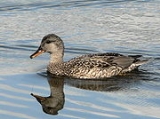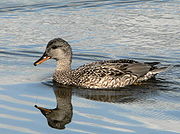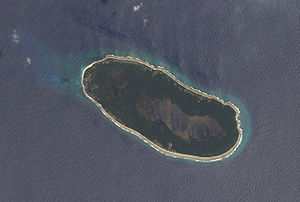
Coues' Gadwall
Encyclopedia
Coues' Gadwall or Washington Island Gadwall (Anas strepera couesi) is an extinct dabbling duck which is only known by two immature specimens from the Pacific island of Teraina
(formerly known as Washington Island—Luther mentions a supposed occurrence on "New York Island", which is merely another old name of Teraina however)Line Islands
, Kiribati
. They are in the National Museum of Natural History
in Washington, D.C.
. The bird was named in honor of Elliott Coues
.
 A male and a female are known, which resemble the immature appearance of the Common Gadwall except for the black bill with a higher number of fuiltering lamellae, black feet, and the much inferior size (which may be due to the birds not being fully grown). The male resembles a male Common Gadwall in eclipse plumage save for some white speckling on the breast and back. The female looks like a small Common Gadwall female; the primary wing coverts were not patterned black, and the inner web of the secondary remiges was grey instead of white.
A male and a female are known, which resemble the immature appearance of the Common Gadwall except for the black bill with a higher number of fuiltering lamellae, black feet, and the much inferior size (which may be due to the birds not being fully grown). The male resembles a male Common Gadwall in eclipse plumage save for some white speckling on the breast and back. The female looks like a small Common Gadwall female; the primary wing coverts were not patterned black, and the inner web of the secondary remiges was grey instead of white.
Measurements are: wing, 19.9 cm; bill, 3.7 cm; tarsus
3.6 cm. This means the birds were the size of a Cape Teal
or Garganey
, with a total length of 40–45 cm. As the birds were not fully adult when shot, it is not clear whether they would not have grown a bit larger.
 The status of this bird is controversial. While many scientists consider it as a dwarfed subspecies
The status of this bird is controversial. While many scientists consider it as a dwarfed subspecies
of the Common Gadwall (Anas strepera strepera) others argue that the two individuals might have been just juveniles of a local breeding population that might not even be taxonomically distinct. The Common Gadwall is a known vagrant to the Tuamotu Islands (Kolbe wrote "Tahiti which is a misreading of Greenway) and Hawaiʻi for example, which are about the same distance from the species' breeding grounds as is Teraina (which moreover lies in between these two groups). This makes it entirely possible that the Washington Island Gadwalls were just the offspring of a few vagrant Common Gadwalls, maybe settling after being wounded by hunters. On the other hand, Streets' reports suggest that there was a population of these ducks of some size present, and thus they may have lived there since quite some time and indeed be worthy of recognition as a distinct taxon
.
The observations of the two individuals took place in January 1874. The species' description was by Thomas Hale Streets (1847–-1925) in 1876. Streets reported about the two immatures he shot and which were found in a peat bog
.
The cause of its extinction might be the extensive hunting by settlers of Tabuaeran
(Fanning Island), which had shot large numbers of migrant ducks on both Teraina and Tabuaeran each year. W.G. Anderson, a local resident stated in 1926 that growing up on Teraina and Tabueran around the turn of the century, he had never encountered a native population of gadwalls on Teraina. Thus, the population's disappearance can be fixed to the last quarter of the 19th century, between the mid-1870s and 1900.
Teraina
Teraina, also known as Washington Island is a coral atoll in the central Pacific Ocean and part of the Northern Line Islands which belongs to Kiribati. Obsolete names of Teraina are Prospect Island and New York Island. The island is located approximately 4.71° North latitude and 160.76° West...
(formerly known as Washington Island—Luther mentions a supposed occurrence on "New York Island", which is merely another old name of Teraina however)Line Islands
Line Islands
The Line Islands, Teraina Islands or Equatorial Islands, is a chain of eleven atolls and low coral islands in the central Pacific Ocean, south of the Hawaiian Islands, that stretches for 2,350 km in a northwest-southeast direction, making it one of the longest islands chains of the world...
, Kiribati
Kiribati
Kiribati , officially the Republic of Kiribati, is an island nation located in the central tropical Pacific Ocean. The permanent population exceeds just over 100,000 , and is composed of 32 atolls and one raised coral island, dispersed over 3.5 million square kilometres, straddling the...
. They are in the National Museum of Natural History
National Museum of Natural History
The National Museum of Natural History is a natural history museum administered by the Smithsonian Institution, located on the National Mall in Washington, D.C., United States. Admission is free and the museum is open 364 days a year....
in Washington, D.C.
Washington, D.C.
Washington, D.C., formally the District of Columbia and commonly referred to as Washington, "the District", or simply D.C., is the capital of the United States. On July 16, 1790, the United States Congress approved the creation of a permanent national capital as permitted by the U.S. Constitution....
. The bird was named in honor of Elliott Coues
Elliott Coues
Elliott Coues was an American army surgeon, historian, ornithologist and author.Coues was born in Portsmouth, New Hampshire. He graduated at Columbian University, Washington, D.C., in 1861, and at the Medical school of that institution in 1863...
.
Description

Measurements are: wing, 19.9 cm; bill, 3.7 cm; tarsus
Tarsus (skeleton)
In tetrapods, the tarsus is a cluster of articulating bones in each foot situated between the lower end of tibia and fibula of the lower leg and the metatarsus. In the foot the tarsus articulates with the bones of the metatarsus, which in turn articulate with the bones of the individual toes...
3.6 cm. This means the birds were the size of a Cape Teal
Cape Teal
The Cape Teal is a 44-46 cm long dabbling duck of open wetlands in sub-Saharan Africa.This species is essentially non-migratory, although it moves opportunistically with the rains. Like many southern ducks, the sexes are similar. It is very pale and mainly grey, with a browner back and pink...
or Garganey
Garganey
The Garganey is a small dabbling duck. It breeds in much of Europe and western Asia, but is strictly migratory, with the entire population moving to southern Africa, India Santragachi and Australasia in winter, where large flocks can occur. This species was first described by Linnaeus in 1758...
, with a total length of 40–45 cm. As the birds were not fully adult when shot, it is not clear whether they would not have grown a bit larger.
Status and extinction

Subspecies
Subspecies in biological classification, is either a taxonomic rank subordinate to species, ora taxonomic unit in that rank . A subspecies cannot be recognized in isolation: a species will either be recognized as having no subspecies at all or two or more, never just one...
of the Common Gadwall (Anas strepera strepera) others argue that the two individuals might have been just juveniles of a local breeding population that might not even be taxonomically distinct. The Common Gadwall is a known vagrant to the Tuamotu Islands (Kolbe wrote "Tahiti which is a misreading of Greenway) and Hawaiʻi for example, which are about the same distance from the species' breeding grounds as is Teraina (which moreover lies in between these two groups). This makes it entirely possible that the Washington Island Gadwalls were just the offspring of a few vagrant Common Gadwalls, maybe settling after being wounded by hunters. On the other hand, Streets' reports suggest that there was a population of these ducks of some size present, and thus they may have lived there since quite some time and indeed be worthy of recognition as a distinct taxon
Taxon
|thumb|270px|[[African elephants]] form a widely-accepted taxon, the [[genus]] LoxodontaA taxon is a group of organisms, which a taxonomist adjudges to be a unit. Usually a taxon is given a name and a rank, although neither is a requirement...
.
The observations of the two individuals took place in January 1874. The species' description was by Thomas Hale Streets (1847–-1925) in 1876. Streets reported about the two immatures he shot and which were found in a peat bog
Bog
A bog, quagmire or mire is a wetland that accumulates acidic peat, a deposit of dead plant material—often mosses or, in Arctic climates, lichens....
.
The cause of its extinction might be the extensive hunting by settlers of Tabuaeran
Tabuaeran
Tabuaeran, also known as Fanning Island or Fanning Atoll is one of the Line Islands of the central Pacific Ocean, and part of Kiribati. It is an atoll located at...
(Fanning Island), which had shot large numbers of migrant ducks on both Teraina and Tabuaeran each year. W.G. Anderson, a local resident stated in 1926 that growing up on Teraina and Tabueran around the turn of the century, he had never encountered a native population of gadwalls on Teraina. Thus, the population's disappearance can be fixed to the last quarter of the 19th century, between the mid-1870s and 1900.

